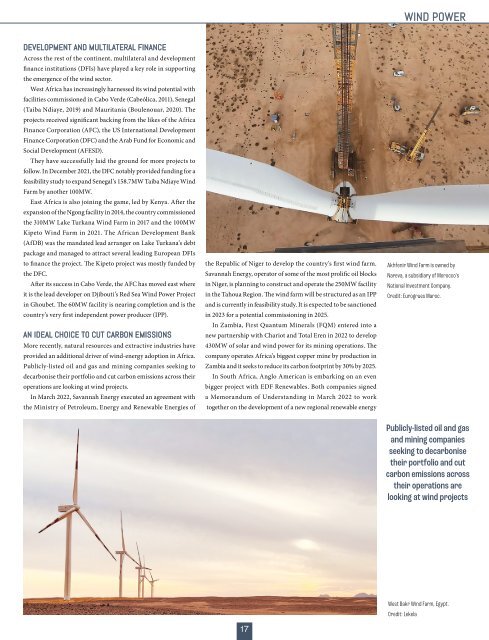Journal of African Business Issue 5
Welcome to The Journal of African Business - a unique guide to business and investment in Africa. Every edition carries editorial copy covering the following general topics, with a wide range of subjects within each broader economic sector: energy; mining and exploration; trade; finance; technology and tourism. In addition to this, special features on topical matters will be published periodically, along with country profiles. In this edition, the in-depth interview with Aggreko Head of Sales, Southern East Africa, Max Schiff, makes clear how important captive power is for the future viability of a wide variety of projects in Africa. As Schiff points out, the extractives industry has long been a leader in the application of captive power, given the remote location of many mining operations, but the flexibility and ESG advantages that captive power using renewables offers is making it an ever-more attractive option for many different sectors.
Welcome to The Journal of African Business - a unique guide to business and investment in Africa.
Every edition carries editorial copy covering the following general topics, with a wide range of subjects within each broader economic sector: energy; mining and exploration; trade; finance; technology and tourism.
In addition to this, special features on topical matters will be published periodically, along with country profiles.
In this edition, the in-depth interview with Aggreko Head of Sales, Southern East Africa, Max Schiff, makes clear how important captive power is for the future viability of a wide variety of projects in Africa. As Schiff points out, the extractives industry has long been a leader in the application of captive power, given the remote location of many mining operations, but the flexibility and ESG advantages that captive power using renewables offers is making it an ever-more attractive option for many different sectors.
Create successful ePaper yourself
Turn your PDF publications into a flip-book with our unique Google optimized e-Paper software.
WIND POWER<br />
DEVELOPMENT AND MULTILATERAL FINANCE<br />
Across the rest <strong>of</strong> the continent, multilateral and development<br />
finance institutions (DFIs) have played a key role in supporting<br />
the emergence <strong>of</strong> the wind sector.<br />
West Africa has increasingly harnessed its wind potential with<br />
facilities commissioned in Cabo Verde (Cabeólica, 2011), Senegal<br />
(Taiba Ndiaye, 2019) and Mauritania (Boulenouar, 2020). The<br />
projects received significant backing from the likes <strong>of</strong> the Africa<br />
Finance Corporation (AFC), the US International Development<br />
Finance Corporation (DFC) and the Arab Fund for Economic and<br />
Social Development (AFESD).<br />
They have successfully laid the ground for more projects to<br />
follow. In December 2021, the DFC notably provided funding for a<br />
feasibility study to expand Senegal’s 158.7MW Taiba Ndiaye Wind<br />
Farm by another 100MW.<br />
East Africa is also joining the game, led by Kenya. After the<br />
expansion <strong>of</strong> the Ngong facility in 2014, the country commissioned<br />
the 310MW Lake Turkana Wind Farm in 2017 and the 100MW<br />
Kipeto Wind Farm in 2021. The <strong>African</strong> Development Bank<br />
(AfDB) was the mandated lead arranger on Lake Turkana’s debt<br />
package and managed to attract several leading European DFIs<br />
to finance the project. The Kipeto project was mostly funded by<br />
the DFC.<br />
After its success in Cabo Verde, the AFC has moved east where<br />
it is the lead developer on Djibouti’s Red Sea Wind Power Project<br />
in Ghoubet. The 60MW facility is nearing completion and is the<br />
country’s very first independent power producer (IPP).<br />
AN IDEAL CHOICE TO CUT CARBON EMISSIONS<br />
More recently, natural resources and extractive industries have<br />
provided an additional driver <strong>of</strong> wind-energy adoption in Africa.<br />
Publicly-listed oil and gas and mining companies seeking to<br />
decarbonise their portfolio and cut carbon emissions across their<br />
operations are looking at wind projects.<br />
In March 2022, Savannah Energy executed an agreement with<br />
the Ministry <strong>of</strong> Petroleum, Energy and Renewable Energies <strong>of</strong><br />
the Republic <strong>of</strong> Niger to develop the country’s first wind farm.<br />
Savannah Energy, operator <strong>of</strong> some <strong>of</strong> the most prolific oil blocks<br />
in Niger, is planning to construct and operate the 250MW facility<br />
in the Tahoua Region. The wind farm will be structured as an IPP<br />
and is currently in feasibility study. It is expected to be sanctioned<br />
in 2023 for a potential commissioning in 2025.<br />
In Zambia, First Quantum Minerals (FQM) entered into a<br />
new partnership with Chariot and Total Eren in 2022 to develop<br />
430MW <strong>of</strong> solar and wind power for its mining operations. The<br />
company operates Africa’s biggest copper mine by production in<br />
Zambia and it seeks to reduce its carbon footprint by 30% by 2025.<br />
In South Africa, Anglo American is embarking on an even<br />
bigger project with EDF Renewables. Both companies signed<br />
a Memorandum <strong>of</strong> Understanding in March 2022 to work<br />
together on the development <strong>of</strong> a new regional renewable energy<br />
Akhfenir Wind Farm is owned by<br />
Nareva, a subsidiary <strong>of</strong> Morocco’s<br />
National Investment Company.<br />
Credit: Eurogrues Maroc.<br />
Publicly-listed oil and gas<br />
and mining companies<br />
seeking to decarbonise<br />
their portfolio and cut<br />
carbon emissions across<br />
their operations are<br />
looking at wind projects<br />
17<br />
West Bakr Wind Farm, Egypt.<br />
Credit: Lekela


















